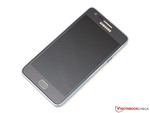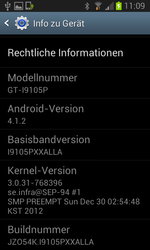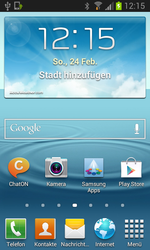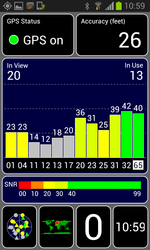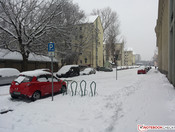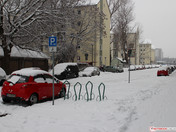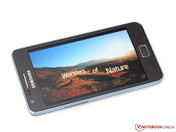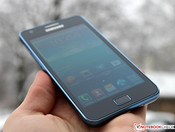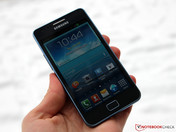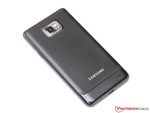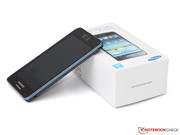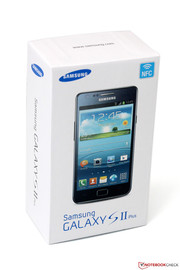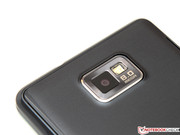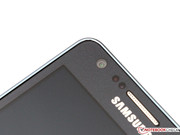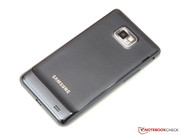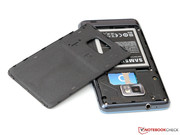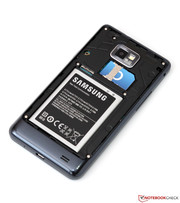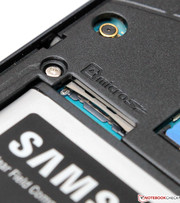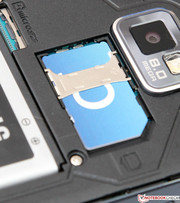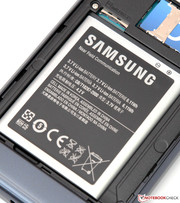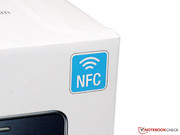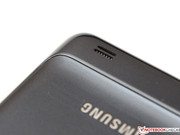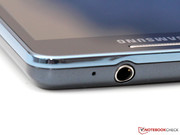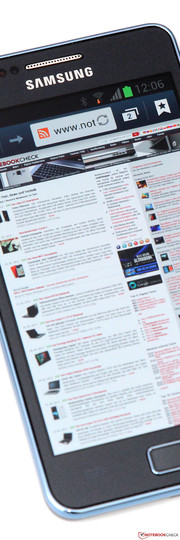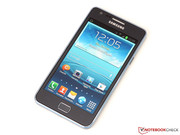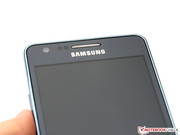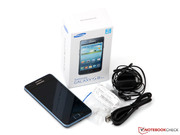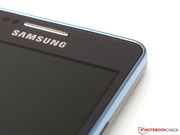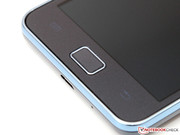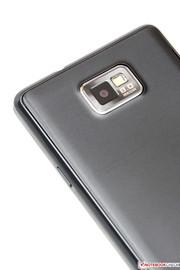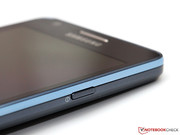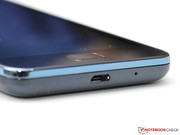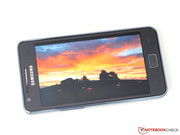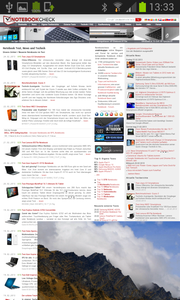Review Samsung Galaxy S2 Plus (i9105P) Smartphone

For the original German review, see here.
In mid-January, the Korean electronics giant Samsung proudly announced that its Galaxy S smartphone series broke the barrier of 100 million sold samples. Analysts expect that at least just as many devices from the upcoming Galaxy S4 top model will be sold.
As excited many customers and the international trade press might be about the latest high-end buster, one thing should be considered: Not every buyer can afford a smartphone from the 500 Euro (~$651) category. Thus, it is all the more important to be well positioned in the lower price ranges – either by offering low-priced entry-level devices or selling older models for an attractive price.
Samsung now relies on just this proven means for the Galaxy S2. Almost two years after the actual release, the manufacturer refreshes the smartphone as Galaxy S2 Plus. But what is behind this name? Many things have been adopted at first glance. The AMOLED screen still features a size of 4.3 inches and a resolution of 800x480 pixels; the dual-core SoC clocks with 1.2 GHz and pictures are shot with an 8.0 megapixel camera. However, Samsung has reduced the storage from 16 to now only 8 GB, which can be tolerated owing to a micro SD slot. The new features, such as the (optional) NFC support or the updated Android operating system (4.1.2 Jelly Bean) alongside the TouchWiz 5.0 user interface, are much more interesting. But is that enough to justify the purchase price of approximately 300 Euros (~$390)?
Case
Samsung has largely adopted the casing's design from the Galaxy S2 precursor. A simple yet quite high-quality plastic dominates the looks. The buyer can choose between the colors blue and white. Stylish details, such as the display's glossy metallic rim let the smartphone look both elegant and unique. The design is in no way stale even after two years. However, one drawback of the glossy surfaces is that every tiny dust particle is seen and makes regular polishing inevitable.
The casing convinces with good stiffness although light metals are not used. Nothing creaks or crackles despite the S2 Plus' thickness of just 8.9 millimeters (~0.35 inches) (without NFC: 8.5 millimeters/~0.34 inches) and a weight of 121 grams (~0.27 pounds). This is insignificantly heavier than the Galaxy S3 Mini (112 grams/~0.25 pounds), which also sports a smaller, 4-inch screen. Unlike Google's Nexus 4, the back cover can be removed without tools. This should however be done with care in view of the fragile-looking clip design.
In terms of build, Samsung has done a great job. We did not find any interfering gaps or sharp edges. The screen covered with Corning's Gorilla Glass closes flush with the bezel and underlines the high-quality claim of the entire device. The S2 Plus can easily compete with the S3 Mini. The iPhone 5's unibody casing is even a bit better due to its design. However, we do not want to use it for direct comparison in view of its much higher price.
Connectivity
Like most other Android smartphones, the Galaxy S2 Plus does not feature many hardware buttons. The power button is on the casing's right and a longish volume rocker is on the other side. Both buttons feature an accurate and firm pressure point and are easy to access with only one hand. The familiar home, menu and back buttons are also available. Both latter buttons are implemented as touch keys.
As usual, the smartphone can be synchronized or recharged over the PC via a micro USB port (USB 2.0, MHL standard). The 3.5 millimeter jack for headsets or headphones as well as the integrated card reader is just as standard. The latter supports micro SD cards up to 64 GB and is a very important extra in view of the tight internal storage.
Software
The Galaxy S2 Plus includes the latest Android 4.1.2, code name "Jelly Bean" version ex-factory. Various innovations have been incorporated with Android 4.1. Some improve the performance ("Project Butter") or supplement new features. For example, the user can now look forward to a virtual, intelligent assistant like Apple's Siri. It offers an increasing scope of features starting with weather forecasts up to browsing through emails. However, a permanent Internet connection is imperative for this service dubbed "Google Now".
The features of Samsung's TouchWiz interface, version 5.0, are just as convenient. One feature that we particularly liked was that video could be placed on the screen as a small pop-up while working with other applications; real multitasking barely known from a smartphone to date.
Communication & GPS
First a minor downside. Similar to the Nexus 4, the S2 Plus unfortunately does not feature mobile Turbo LTE technology. Apart from this flaw, the smartphone's connectivity can be called decent. Gross data rates of up to 21.6 Mbit/s in downlink and 5.76 Mbit/s in uplink are possible in UMTS networks with HSPA(+). Owing to quad-band support (GSM: 850/900/1800/1900 MHz; UMTS: 850/900/1900/2100 MHz) and W-CDMA, the user can make calls and browse almost everywhere in the world.
Besides the compulsory Wi-Fi 802.11 a/b/g/n and Bluetooth version 3.0 standard, a few versions of the Galaxy S2 Plus offer NFC (near-field communication). Samsung adds a "P" at the end of the model name (i9105P) and offers these devices for virtually the same purchase price. Although this standard is not yet very widespread in Germany, the diversity of application fields, such as micro-payment, key lock, general data sharing over short distances, should not be underestimated for the future.
The smartphone can use both the signals from the American GPS satellites as well as the Russian Glonass system for position finding, which is particularly important for navigation applications. Thus, the likelihood of determining the exact position coordination increases when the reception conditions are poor.
Telephony
The clearly arranged telephone application will not cause problems for new smartphone users and impresses with sophisticated operation. Swiping over contacts from the left to right automatically prompts a call; swiping in the other direction opens the message screen. Calls using enabled "Direct Call" are even easier. The phone is simply held to the ear and the opened contact is automatically called.
Cameras & Multimedia
The rear-facing camera in the S2 Plus has a decent resolution of 8.0 megapixels (3264x2448 pixels) and surpasses the company's own competition, such as the Galaxy S3 Mini (5.0 megapixels). The result is focused pictures featuring balanced colors that can compete with the compared contenders. Of course, an LED flash and video feature, which records in a Full HD resolution, is also included. The autofocus could be a bit faster, but this is insignificant to the overall good impression.
Our verdict about the front-facing camera is more negative, as expected. With 2.0 megapixels (1600x1200 pixels) and accordingly low details, it is mainly thought for video chats. These are however limited to a lower resolution of 720x480 pixels.
Accessories
Besides the smartphone and the battery, a matching power supply unit, USB cord and an in-ear headset with various pads is included. , The user will not find any other accessories, such as a memory card or case, but neither among most contenders.
Warranty
Samsung includes a 24-month manufacturer's warranty on material and processing flaws for all its current smartphones. However, it only applies to the device. The warranty on all accessories is limited to a meager 6 months. Of course, this does not affect the 2-year statutory warranty.
Input Devices & Controls
Users who have dealt with other Android devices will quickly be accustomed to using the Galaxy S2 Plus. The touchscreen as the main input can be used precisely and without delays. It is also big enough to accurately hit every letter even on the selected QWERY keyboard. Apart from minor differences, the layout corresponds to the usual Android standard. Nostalgists can also choose a classic mobile phone layout with large number buttons.
Display
The smartphone world has gone pixel crazy. The manufacturers are quickly closing in on 500 dpi, Full HD screens like in the new HTC One. Such high resolutions can naturally not (yet) be expected from a 300 Euro (~$390) device. However, the 800x480 pixels displayed by the Galaxy S2 Plus seem rather outdated nowadays. We would appreciate at least qHD (960x540 pixels) in a 4.3-inch screen. It not only improves the font quality, but also increases the comfort while browsing because more information can be displayed at the same time. At least Samsung does not use the so-called PenTile matrix that works with a reduced sub-pixel count.
| |||||||||||||||||||||||||
Brightness Distribution: 96 %
Center on Battery: 239 cd/m²
Contrast: ∞:1 (Black: 0 cd/m²)
The great picture quality on the Super AMOLED Plus screen compensates the user for the somewhat disappointing resolution. OLED screens are traditionally known for brilliant colors and a virtually perfect black reproduction; strengths that the S2 Plus once again confirms. Our gauge even failed to measure a contrast rate simply because no remaining brightness was measurable in black picture components. Pictures, movies and games are rendered accordingly saturated and plastic. The higher the contrast in a scene, the bigger the advantage over a normal IPS screen.
One of the most important qualities of a smartphone is outdoor use. Consequently, it must have sufficient brightness in addition to good image quality. The Galaxy S2 Plus cannot completely convince us with its average brightness of 240 cd/m². Most models on the market easily achieve 400 to 500 cd/m². Since the screen's surface is reflective like all smartphones, direct sunlight should be avoided where possible. The same is true for the Galaxy S3 (Mini) and many other contenders.
IPS screens already offer a largely undistorted content representation even at very acute angles. Nevertheless, the AMOLED screen in our test device clearly excels that and maintains its great contrasts and colors from every thinkable position. Although the equally expensive Nexus 4 is superior in many things, this plus point goes to the S2 Plus.
Performance
The S2 Plus showed up for our benchmark tests with an apparently unmodified 1.2 GHz SoC featuring two processing cores. However, a few differences are noticed when looking closely. After using chips from its own Exynos range (Exynos 4210 in the S2 i9100) and Texas Instruments (TI OMAP 4430 in the S2 i9100G), Samsung now relies on a Broadcom BCM28155.
The new SoC should hardly feature any surprises on the CPU side. The cores are still based on the Cortex A9 architecture (ARMv7 including NEON extension) and can access the 1 GB LPDDR2 memory via two 32-bit channels. However, the manufacturing process has been improved from 45 nm to 40 nm LP, which lets us hope for a lower power consumption and consequently longer battery runtimes.
A big stranger is the graphics card named "VideoCore IV". There were significant performance differences between both former SoCs, which partly attested the Exynos chip to have twice the power of the TI derivative. We will now examine how the Galaxy S2 Plus fares in comparison to midrange contenders, such as Google's Nexus 4 (Snapdragon S4 Pro, Adreno 320, 2 GB RAM).
| GLBenchmark 2.5 - 1920x1080 Egypt HD Offscreen Fixed Time (sort by value) | |
| Samsung Galaxy S2 Plus | |
| Google Nexus 4 | |
| Samsung Galaxy S3 | |
| Samsung S3 Mini GT-I8190 | |
| Smartbench 2012 - Productivity Index (sort by value) | |
| Samsung Galaxy S2 Plus | |
| Google Nexus 4 | |
| Samsung Galaxy S3 | |
| Samsung S3 Mini GT-I8190 | |
| Linpack Android / IOS - Multi Thread (sort by value) | |
| Samsung Galaxy S2 Plus | |
| Google Nexus 4 | |
| Samsung Galaxy S3 | |
| Samsung S3 Mini GT-I8190 | |
| NenaMark2 - --- (sort by value) | |
| Samsung Galaxy S2 Plus | |
| Google Nexus 4 | |
| Samsung Galaxy S3 | |
| Samsung S3 Mini GT-I8190 | |
| AnTuTu v3 - Total Score (sort by value) | |
| Samsung Galaxy S2 Plus | |
| Google Nexus 4 | |
| Samsung Galaxy S3 | |
| Samsung S3 Mini GT-I8190 | |
| Epic Citadel - High Quality (sort by value) | |
| Samsung Galaxy S2 Plus | |
| Google Nexus 4 | |
| Quadrant Standard Edition 2.0 - --- (sort by value) | |
| Samsung Galaxy S2 Plus | |
| Google Nexus 4 | |
| Samsung Galaxy S3 | |
| Samsung S3 Mini GT-I8190 | |
In the average of the synthetic benchmarks we tested, the Galaxy S2 Plus places itself clearly behind the Galaxy S3 premium model but still before the S3 Mini. The Nexus 4 from Google is unconditionally at the top. The hardware power it offers in this price range will likely remain unreached for a while. We were particularly surprised about the graphics power of the S2 Plus. Although the VideoCore GPU benefits from the screen's low resolution in the Epic Citadel benchmark - the Nexus 4 has to manage over twice the pixel count - the reached 52.6 fps are very impressive. The Galaxy S2 (i9100) precursor only managed around 34 fps.
| Browsermark - --- (sort by value) | |
| Samsung Galaxy S2 Plus | |
| Samsung S3 Mini GT-I8190 | |
| Samsung Galaxy S3 | |
| Google Nexus 4 | |
| HTC Windows Phone 8S | |
| Google V8 Ver. 7 - Google V8 Ver. 7 Score (sort by value) | |
| Samsung Galaxy S2 Plus | |
| Samsung S3 Mini GT-I8190 | |
| Samsung Galaxy S3 | |
| Google Nexus 4 | |
| HTC Windows Phone 8S | |
| Sunspider | |
| 1.0 Total Score (sort by value) | |
| Google Nexus 4 | |
| 0.9.1 Total Score (sort by value) | |
| Samsung Galaxy S2 Plus | |
| Samsung S3 Mini GT-I8190 | |
| Samsung Galaxy S3 | |
| Google Nexus 4 | |
| HTC Windows Phone 8S | |
* ... smaller is better
The S2 Plus compels with a constantly impeccable operation in practical use, owing to "Project Butter" and a highly optimized Browser. Even large websites open within seconds: Scrolling or zooming is absolutely smooth and without interruptions. Our test device even surpasses the superior Nexus 4 in two of three browser benchmarks on paper.
Another reason for the good routine performance is the swift flash memory. It is quite tight with only 8 GB (3.7 GB free), but the transfer rates are absolute premium level. Even the more expensive Galaxy S3 is impressively shown its limits with over 47 MB/s in read and good 15 MB/s in write (both sequential).
| AndroBench 3-5 | |
| Random Write 4KB (sort by value) | |
| Samsung Galaxy S2 Plus | |
| Google Nexus 4 | |
| Samsung S3 Mini GT-I8190 | |
| Samsung Galaxy S3 | |
| Random Read 4KB (sort by value) | |
| Samsung Galaxy S2 Plus | |
| Google Nexus 4 | |
| Samsung S3 Mini GT-I8190 | |
| Samsung Galaxy S3 | |
| Sequential Write 256KB (sort by value) | |
| Samsung Galaxy S2 Plus | |
| Google Nexus 4 | |
| Samsung S3 Mini GT-I8190 | |
| Samsung Galaxy S3 | |
| Sequential Read 256KB (sort by value) | |
| Samsung Galaxy S2 Plus | |
| Google Nexus 4 | |
| Samsung S3 Mini GT-I8190 | |
| Samsung Galaxy S3 | |
Games
We tested whether the Galaxy S2 Plus can really cope with graphically demanding 3D games using two free tracks from the Play Store. In Temple Run 2, we could convince ourselves of the installed hardware's performance (estimated frame rate: over 30 fps) as well as the accuracy of all sensors. Also, all inputs via the touchscreen were implemented directly and with high accuracy.
The online shooter ShadowGun: DeadZone did not run quite as smoothly with a frame rate of approximately 25 fps, but is playable without major restrictions. The Galaxy S2 Plus will have enough reserves for 2D games like Angry Birds anyway.
Speech Quality
All the features sometimes let us forget the real purpose of a phone or smartphone, namely making calls. The S2 Plus could exhibit a quite good and stable reception in our test, which is comparable with other smartphones such as Sony's Xperia Play and HTC's Evo 3D. The speech quality of our test device proved to be equally good on both sides. Owing to the receiver's high maximum volume, it is easily possible to make calls at conventions or other loud surroundings.
Emissions
Temperature
Unlike some other premium models featuring an energy guzzling quad-core SoC, the dual-core in the S2 Plus does not produce much waste heat. The casing's surface reached a maximum of approx. 37 °C (98.6 °F) even during constant full load, which is roughly lukewarm. We consequently also did not notice throttling when the processor and graphics card were loaded simultaneously. The smartphone even remained completely cold in idle or routine use (making calls, watching videos, light browsing). This indicates a very low power consumption, but more about that later.
(+) The maximum temperature on the upper side is 36.4 °C / 98 F, compared to the average of 35.2 °C / 95 F, ranging from 21.9 to 247 °C for the class Smartphone.
(+) The bottom heats up to a maximum of 37 °C / 99 F, compared to the average of 34 °C / 93 F
(+) In idle usage, the average temperature for the upper side is 27.2 °C / 81 F, compared to the device average of 32.9 °C / 91 F.
Speakers
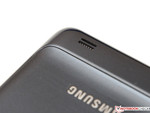
The mono speaker located on the S2 Plus' back impresses with a surprisingly clear and sufficient maximum volume. However, the volume reserves cannot always be completely used depending on the music style. Especially high pitches tend to quickly overdrive slightly. Some other smartphones also render bass a bit better so that a headphone or headset should be used for ideal music enjoyment in any event. The included in-ear model (EHS64AVFWE) is the same as we know from the Galaxy S3 model. Its sound quality and wearing comfort (6 different pads) range within a good midfield.
Energy Management
Power Consumption
The smartphone proved to be a bit more energy hungry than expected with an idle power consumption of 1.0 to 1.8 Watts. Comparable phones usually consume a few hundred milliwatts less. Considering the massive influence of idle consumption by the power supply unit, we do not want to analyze these figures in-depth.
More significant are the full load rates. As expected, the dual-core SoC consumption of 2.2 to 2.6 Watts is much more efficient than the quad-core counterparts in the Galaxy S3 (3.3 to 3.4 Watts) or the Nexus 4 (3.9 to 6.5 Watts). This should have a positive effect on the battery life, which we will look at next.
| Off / Standby | |
| Idle | |
| Load |
|
Key:
min: | |
Battery Runtime
The removable back cover allows the user to take out and replace the 6.1 Wh battery in case of damage or heavy wear. Based on the installed hardware and screen size, the battery has a completely sufficient capacity, which allowed a maximum runtime of over 14 hours (Wi-Fi on, minimum brightness, reading a text file).
The battery's reserves were drained after 9 hours and 38 minutes when the screen's brightness is adapted (approx. 150 cd/m²) and we surfed via Wi-Fi. The Galaxy S2 Plus lasts for about just as long as the S3 Mini or Motorola RAZR i in this practical scenario. The Nexus 4 gives up about two hours earlier. Most users will have to connect the S2 Plus to the mains every second day, which is not a bad result for a modern smartphone.
The runtime dropped to a bit over 4 hours when the processor and graphics card were loaded using the Stability Test app. The power supply unit should be close at hand during long gaming sessions.
Verdict
We admit, since Google offered a premium smartphone for a giveaway price with its Nexus 4, other manufacturers have a hard time scoring with their midrange models. Nevertheless, Samsung's Galaxy S2 Plus largely convinced us, which we would like to summarize here.
We will start with the casing. Its build, feel and stability do not give reason for complaint although the smartphone is extremely slim and light. The 4.3-inch screen is a perfect compromise between image size and pocket-suitability. Only the resolution is no longer quite up-to-date. However, the AMOLED technology excites with its brilliant image quality that is not excelled by any IPS screen.
The dual-core SoC's performance roughly corresponds to the 2-year-old precursor model. The user interface animation is smooth as silk and websites are loaded extremely fast - a swift browser and Android 4.1 make it possible. The features of Samsung's TouchWiz 5.0 also offer a real added value in contrast to some contenders. A decent 8-megapixel camera, NFC and the extremely handy micro SD slot add to that.
The bottom line is; the S2 Plus has clearly earned its purchase recommendation, even if the current price of 300 Euros (~$390) is definitely not a bargain. Consequently, the Nexus 4 remains to be the unchallenged star in the Android camp for enthusiasts who place particular importance on the latest hardware (at least in this price category).




